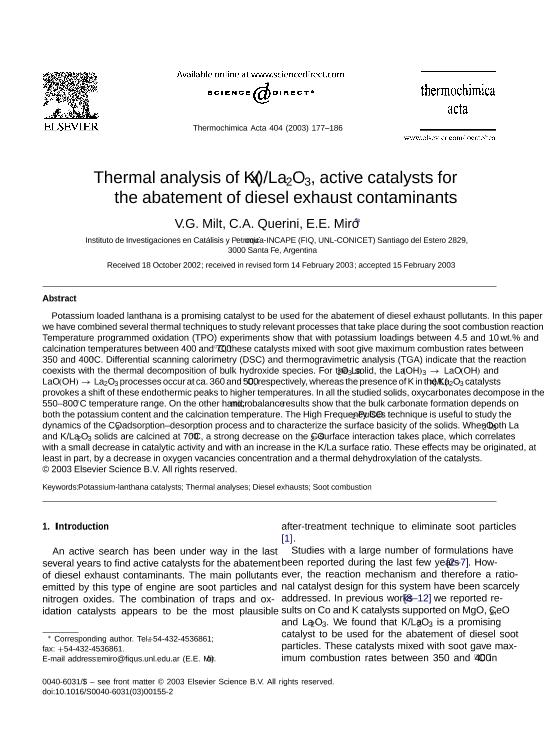Mostrar el registro sencillo del ítem
dc.contributor.author
Milt, Viviana Guadalupe

dc.contributor.author
Querini, Carlos Alberto

dc.contributor.author
Miro, Eduardo Ernesto

dc.date.available
2018-03-27T13:28:07Z
dc.date.issued
2003-09
dc.identifier.citation
Milt, Viviana Guadalupe; Querini, Carlos Alberto; Miro, Eduardo Ernesto; Thermal analysis of K(x)/La2O3, active catalysts for the abatement of diesel exhaust contaminants; Elsevier Science; Thermochimica Acta; 404; 1-2; 9-2003; 177-186
dc.identifier.issn
0040-6031
dc.identifier.uri
http://hdl.handle.net/11336/40101
dc.description.abstract
Potassium loaded lanthana is a promising catalyst to be used for the abatement of diesel exhaust pollutants. In this paper we have combined several thermal techniques to study relevant processes that take place during the soot combustion reaction. Temperature programmed oxidation (TPO) experiments show that with potassium loadings between 4.5 and 10 wt.% and calcination temperatures between 400 and 700 °C, these catalysts mixed with soot give maximum combustion rates between 350 and 400 °C. Differential scanning calorimetry (DSC) and thermogravimetric analysis (TGA) indicate that the reaction coexists with the thermal decomposition of bulk hydroxide species. For the La2O3 solid, the La(OH)3→LaO(OH) and LaO(OH)→La2O3 processes occur at ca. 360 and 500 °C, respectively, whereas the presence of K in the K(x)/La2O3 catalysts provokes a shift of these endothermic peaks to higher temperatures. In all the studied solids, oxycarbonates decompose in the 550–800 °C temperature range. On the other hand, microbalance results show that the bulk carbonate formation depends on both the potassium content and the calcination temperature. The High Frequency CO2 Pulses technique is useful to study the dynamics of the CO2 adsorption–desorption process and to characterize the surface basicity of the solids. When both La2O3 and K/La2O3 solids are calcined at 700 °C, a strong decrease on the CO2–surface interaction takes place, which correlates with a small decrease in catalytic activity and with an increase in the K/La surface ratio. These effects may be originated, at least in part, by a decrease in oxygen vacancies concentration and a thermal dehydroxylation of the catalysts.
dc.format
application/pdf
dc.language.iso
eng
dc.publisher
Elsevier Science

dc.rights
info:eu-repo/semantics/openAccess
dc.rights.uri
https://creativecommons.org/licenses/by-nc-sa/2.5/ar/
dc.subject
Potassium-Lanthana Catalysts
dc.subject
Thermal Analyses
dc.subject
Diesel Exhausts
dc.subject
Soot Combustion
dc.subject.classification
Otras Ingeniería Química

dc.subject.classification
Ingeniería Química

dc.subject.classification
INGENIERÍAS Y TECNOLOGÍAS

dc.title
Thermal analysis of K(x)/La2O3, active catalysts for the abatement of diesel exhaust contaminants
dc.type
info:eu-repo/semantics/article
dc.type
info:ar-repo/semantics/artículo
dc.type
info:eu-repo/semantics/publishedVersion
dc.date.updated
2018-03-16T15:42:44Z
dc.journal.volume
404
dc.journal.number
1-2
dc.journal.pagination
177-186
dc.journal.pais
Países Bajos

dc.journal.ciudad
Amsterdam
dc.description.fil
Fil: Milt, Viviana Guadalupe. Consejo Nacional de Investigaciones Científicas y Técnicas. Centro Científico Tecnológico Conicet - Santa Fe. Instituto de Investigaciones en Catálisis y Petroquímica ; Argentina
dc.description.fil
Fil: Querini, Carlos Alberto. Consejo Nacional de Investigaciones Científicas y Técnicas. Centro Científico Tecnológico Conicet - Santa Fe. Instituto de Investigaciones en Catálisis y Petroquímica ; Argentina
dc.description.fil
Fil: Miro, Eduardo Ernesto. Consejo Nacional de Investigaciones Científicas y Técnicas. Centro Científico Tecnológico Conicet - Santa Fe. Instituto de Investigaciones en Catálisis y Petroquímica "Ing. José Miguel Parera". Universidad Nacional del Litoral. Instituto de Investigaciones en Catálisis y Petroquímica "Ing. José Miguel Parera"; Argentina
dc.journal.title
Thermochimica Acta

dc.relation.alternativeid
info:eu-repo/semantics/altIdentifier/doi/https://doi.org/10.1016/S0040-6031(03)00155-2
dc.relation.alternativeid
info:eu-repo/semantics/altIdentifier/url/https://www.sciencedirect.com/science/article/pii/S0040603103001552
Archivos asociados
